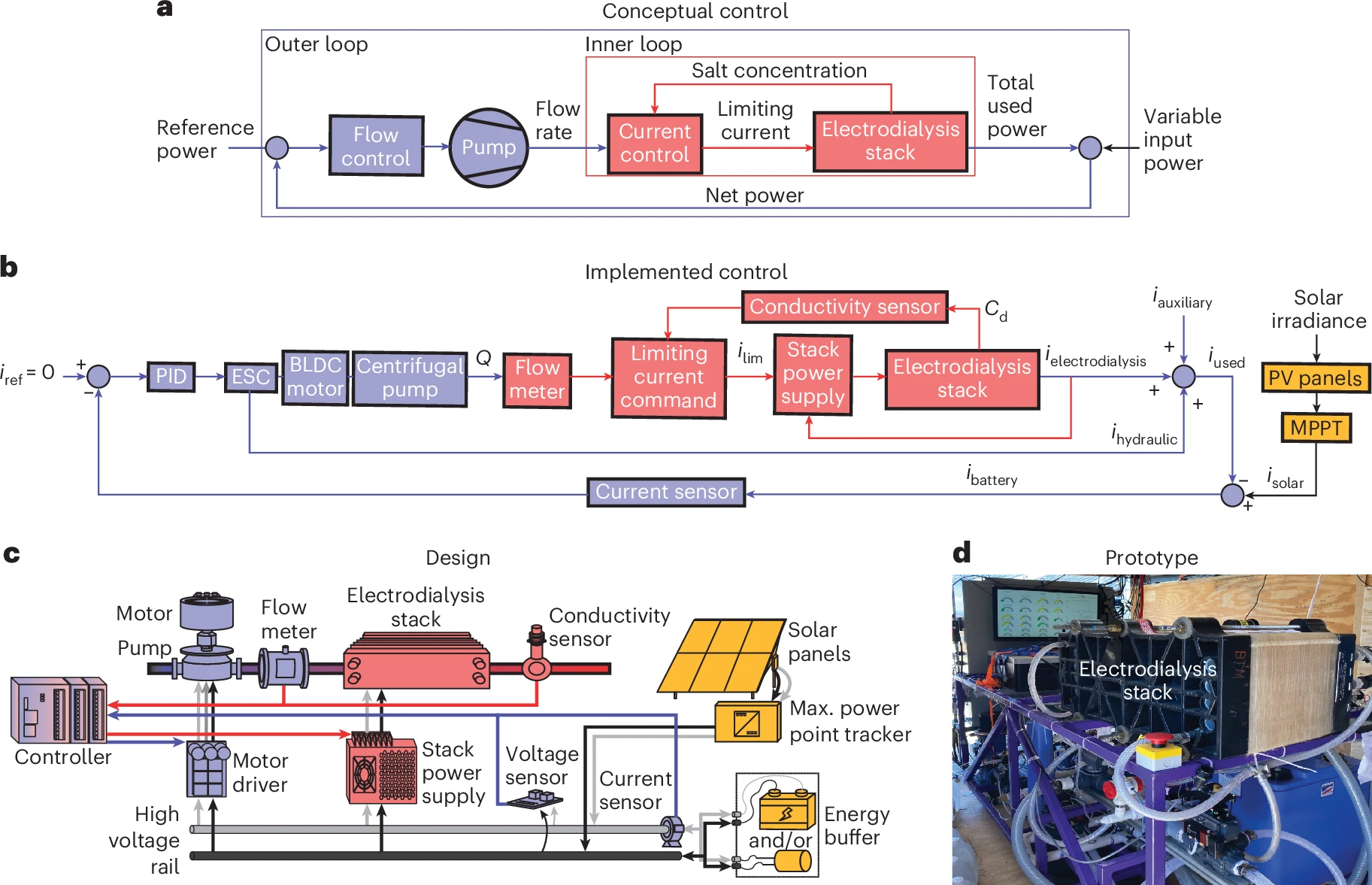A breakthrough in desalination technology could transform access to clean water in rural and underserved communities. The study published in Nature Water, demonstrates a novel and simple solution to harness solar energy for desalination. This research is particularly important for resource-constrained areas where conventional desalination technologies, which rely on large energy storage systems, are impractical and costly.
What is desalination?
Desalination is the process of removing salts from water. Desalination is crucial in areas where groundwater is the only source of drinking water. As the global climate continues to warm, groundwater salinity is becoming a growing concern, particularly in low- and middle-income countries. Traditional desalination methods, like reverse osmosis (RO), require constant power and large-scale infrastructure, which limits their use in rural areas. This new research offers a more flexible and sustainable solution by utilizing photovoltaic (solar) energy to power an electrodialysis (ED) system. This system can operate directly on solar energy, with little or no need for battery storage, drastically reducing costs and complexity.
Important aspect of that research
One of the most exciting aspects of this research is the introduction of a simple control system, called flow-commanded current control (FCCC), which allows the desalination process to adjust dynamically to the amount of solar energy available. Bessette and his team designed and tested a community-scale desalination system that used this control strategy over a six-month period in New Mexico, using real brackish groundwater. The system proved to be highly efficient, capturing 94% of the available solar energy and producing up to 5.3 cubic meters of desalinated water per day, all while using 99% less energy storage than comparable systems in the literature.
This is a game changer. As Bessette explains, “We’ve demonstrated that it’s possible to provide clean water to communities using a very simple system that doesn’t rely on expensive batteries or complex predictive models.” This means that smaller, decentralized communities—many of which are the hardest hit by water shortages—could now benefit from clean water without the need for sophisticated infrastructure or the high operational costs traditionally associated with desalination.
The key to the system’s success lies in its ability to adjust power consumption in real-time based on solar availability. Unlike traditional desalination methods, which require constant energy input, the FCCC system allows the desalination process to scale up or down with the sun’s energy. When there is more solar power available, the system increases the flow rate of water through the desalination membranes, thereby increasing the water production rate. When the power decreases, the system slows down, but it continues to operate efficiently without shutting down entirely. This adaptability is critical in regions where the availability of renewable energy is intermittent.
Electrodialysis, the technology at the heart of this system, works by using an electric field to separate ions (such as salts) from water. It’s particularly well-suited to brackish water, which has lower salt concentrations than seawater, and it uses less energy than reverse osmosis. The energy savings are further amplified by the fact that the system can run on solar power directly, without needing the large energy storage systems that other desalination technologies require. This not only cuts costs but also makes the system more environmentally friendly by reducing its overall energy footprint.
Another significant advantage of this technology is its durability and ease of maintenance. The researchers found that the electrodialysis membranes used in their system can last up to 20 years, even in harsh conditions. Additionally, the system is designed to handle a wide range of water qualities, from low to high salinity, which makes it versatile enough for use in various locations.
However, this innovation is not without its challenges. For one, the system’s performance depends heavily on the quality of the hardware used, such as pumps and membranes. If these components are not carefully selected, the system may not be able to fully take advantage of the available solar energy.
“It’s important to choose the right equipment to ensure that the system operates within its optimal power range. A slightly larger pump, for example, might increase costs but could greatly enhance power tracking and overall efficiency,” Bessette stated.
Despite these hurdles, the study’s results are incredibly promising. The long-term tests showed that the system could consistently produce high-quality water with salinity levels below the target of 1,000 μS/cm, making it suitable for drinking. And while the initial system used commercially available components, the authors suggest that further optimization and scale could drive down costs even more, making this technology accessible to a wider range of communities.
The potential implications of this research extend beyond small, decentralized communities. As larger desalination plants could also benefit from integrating this technology. By using the FCCC system to handle part of the desalination process, such as in pre-treatment stages, large-scale plants could reduce their reliance on fossil fuels and decrease their carbon footprint.
The innovation doesn’t stop at desalination, either. The FCCC control strategy could be adapted to other electrochemical processes, such as carbon capture, agricultural water treatment, or even fuel cell applications. This versatility makes the technology a valuable tool in the broader effort to decarbonize industries and reduce the global reliance on traditional energy sources.
For more, visit: https://doi.org/10.1038/s44221-024-00314-6



